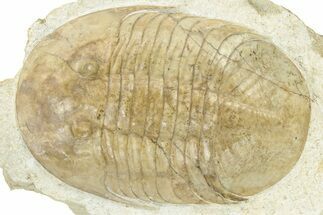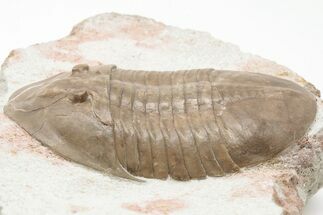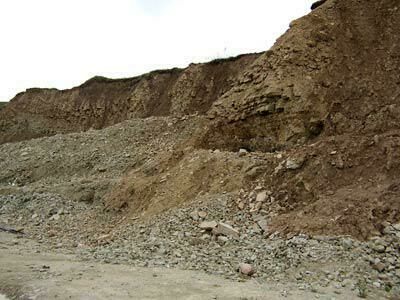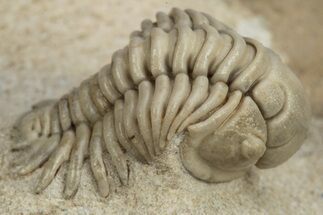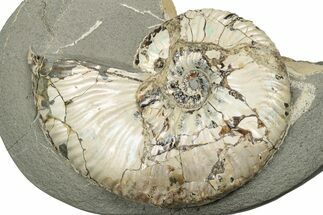This Specimen has been sold.
Illaenus plautini with Cystoid
Here is a sweet Illaenus plautini trilobite associated with the cystoid Echinosphaerites aurantium. This 480 million year old trilobite looks ready to crawl off the rock. The prep work is masterful and the carmel colored shell displays well against the white limestone matrix. Impressive piece.
Like most Russian trilobites it does have some restoration but it is very minor (2-3%) It consistes of a small touchup at the top of each eye, two spots on the tail to replace flaked off shell and touchups on two of the right hand side pleural tops. This is nearly pristine for your typical Russian Illaenus.
Like most Russian trilobites it does have some restoration but it is very minor (2-3%) It consistes of a small touchup at the top of each eye, two spots on the tail to replace flaked off shell and touchups on two of the right hand side pleural tops. This is nearly pristine for your typical Russian Illaenus.
Cystoids are extinct echinoderms similar to crinoids. They consist of a stalk, theca (body), and brachials (feeding arms). Most lived fixed to the seafloor, but some were more mobile. Like modern echinoderms, cystoids were arranged in a fivefold symmetric pattern and had a water vascular system. However, unlike most echinoderms, cystoids had triangular calcite plates at their body openings containing pores that are thought to have been for breathing.
Cystoids first appear in the Cambrian Period and reached peak diversity during the Ordivician and Silurian Periods. Cystoids died out at the end of the Devonian or early in the Carboniferous Period.
Cystoids resembled flowers, but were in fact animals. They had a stem that attached them to the seafloor, a theca, and brachials. The theca contained the cystoid's vital organs and was made up of calcite plates that formed a spherical or ovate body. The brachials were the feeding arms that extended from the top of the theca, arranged in three- or five-fold symmetry, and funneled food to the mouth at their center. Cystoids and crinoids look similar but have some distinct differences. The main difference is in the shape of the main body of the organisms: cystoids had a spherical or ovate theca, while crinoids had a cup shaped calyx. Cystoids also had triangular plates at body openings while crinoids had variably shaped plates.
Cystoids first appear in the Cambrian Period and reached peak diversity during the Ordivician and Silurian Periods. Cystoids died out at the end of the Devonian or early in the Carboniferous Period.
Cystoids resembled flowers, but were in fact animals. They had a stem that attached them to the seafloor, a theca, and brachials. The theca contained the cystoid's vital organs and was made up of calcite plates that formed a spherical or ovate body. The brachials were the feeding arms that extended from the top of the theca, arranged in three- or five-fold symmetry, and funneled food to the mouth at their center. Cystoids and crinoids look similar but have some distinct differences. The main difference is in the shape of the main body of the organisms: cystoids had a spherical or ovate theca, while crinoids had a cup shaped calyx. Cystoids also had triangular plates at body openings while crinoids had variably shaped plates.
SPECIES
Illaenus plautini and Echinosphaerites aurantium
AGE
LOCATION
Vilpovitsy quarry, St.Petersburg region, Russia
FORMATION
Asery level
SIZE
1.9"
CATEGORY
SUB CATEGORY
ITEM
#466
We guarantee the authenticity of all of our specimens.
 Reviews
Reviews


